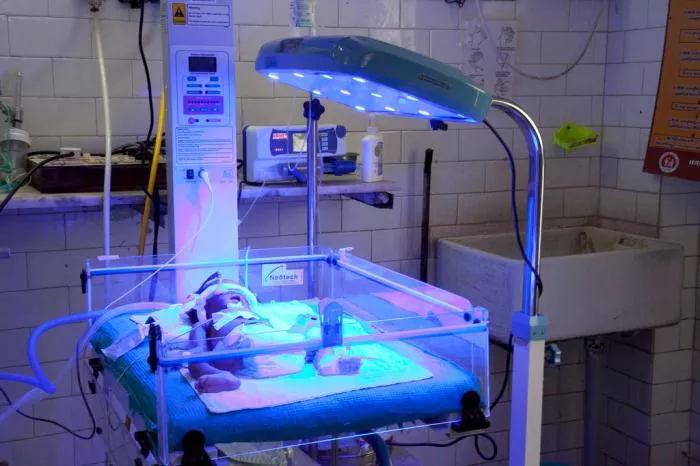Phototherapy is a common treatment for newborns with jaundice. Jaundice occurs when there is too much bilirubin in the blood. Bilirubin is a yellow substance that the body produces when it breaks down red blood cells. While jaundice is common in newborns, it can lead to serious health problems if not treated.
Phototherapy helps reduce bilirubin levels. This treatment uses special lights to change bilirubin into a form that can be easily removed from the body. This article explains how long phototherapy typically lasts and what to expect during treatment.
Understanding Jaundice in Newborns
Jaundice is a condition that affects many newborns. It occurs when the liver is not yet fully developed. This means it cannot process bilirubin efficiently. As a result, bilirubin builds up in the blood, causing the skin and eyes to appear yellow.
There are different types of jaundice in newborns. The most common type is physiological jaundice. This type usually appears two to three days after birth and resolves within two weeks.
Pathological jaundice is more severe. It can appear within the first 24 hours of life and may require immediate treatment. It is important for parents to monitor their newborns for signs of jaundice and seek medical attention if necessary.
When Is Phototherapy Needed?
Doctors recommend phototherapy when a newborn’s bilirubin levels are too high. Each hospital may have different guidelines, but treatment is generally considered when bilirubin levels reach a certain threshold.
For healthy term babies, phototherapy is usually indicated if the bilirubin level is above 15 mg/dL in the first 24 hours of life. For preterm infants, the threshold is lower due to their increased risk of complications.
It is essential to consult with a healthcare professional to determine the need for phototherapy.
Duration of Phototherapy
The duration of phototherapy can vary based on several factors. The main factors include the newborn’s age, the cause of jaundice, and the bilirubin levels.
In most cases, phototherapy lasts between 24 to 72 hours. However, treatment may continue longer if bilirubin levels do not decrease.
The healthcare team will regularly check the bilirubin levels during treatment. They will use a special device called a transcutaneous bilirubin meter or a blood test to monitor levels.
If bilirubin levels drop to a safe range, the healthcare team will discontinue phototherapy.
Types of Phototherapy
There are different types of phototherapy used for newborns. The most common types are:
Conventional Phototherapy
Conventional phototherapy involves using special fluorescent lights. These lights emit blue light, which helps break down bilirubin in the skin.
During treatment, the baby is placed under the lights while wearing only a diaper. Eye protection is also provided to prevent damage to the baby’s eyes.
Intensive Phototherapy
Intensive phototherapy is used for newborns with high bilirubin levels. This type of treatment uses more lights and covers a larger area of the baby’s body.
Intensive phototherapy may also involve using a fiber-optic blanket. This blanket emits light and can be used in addition to traditional lights.
Home Phototherapy
In some cases, healthcare providers may recommend home phototherapy. This is suitable for mild jaundice cases and requires a special phototherapy device for home use.
Parents must closely monitor their baby’s bilirubin levels during home treatment.
Monitoring During Phototherapy
While undergoing phototherapy, newborns are closely monitored. Nurses and doctors will check bilirubin levels frequently. They will also observe the baby for any side effects from the treatment.
Common side effects are:
Dehydration: Phototherapy can cause the baby to lose fluids. It is important to ensure the baby is feeding well to stay hydrated.
Skin irritation: The lights can sometimes cause mild skin irritation or rashes.
Temperature regulation: Babies may become too warm or too cool under the lights. Healthcare providers will monitor their temperature closely.
If any side effects occur, healthcare providers will address them promptly.
Comfort Measures During Treatment
Parents can help keep their newborns comfortable during phototherapy. Here are some tips:
Feeding
It is crucial to ensure that the baby is feeding regularly. This helps prevent dehydration and promotes the elimination of bilirubin through urine and stool.
Swaddling
Swaddling can provide comfort and warmth to the baby. However, it is important not to cover the areas exposed to the light.
Holding and Soothing
When not under the lights, parents can hold and soothe their newborns. Skin-to-skin contact is beneficial for both the baby and the parent.
When Is Phototherapy Discontinued?
Phototherapy is discontinued when the baby’s bilirubin levels fall within the safe range. The healthcare team will communicate with the parents about the results and treatment plan.
Once phototherapy is completed, doctors may still monitor the baby for any signs of returning jaundice. Parents should continue to watch for any yellowing of the skin or eyes.
Follow-Up Care
After phototherapy, follow-up care is important. Healthcare providers may schedule a follow-up appointment to check bilirubin levels. This ensures that the levels remain stable after treatment.
Parents should report any concerns or changes in their baby’s behavior, feeding patterns, or appearance.
See also: What Is Phototherapy Used For In Newborns
Conclusion
Phototherapy is a safe and effective treatment for jaundice in newborns. The duration of treatment typically ranges from 24 to 72 hours, depending on the baby’s bilirubin levels and age.
Monitoring and comfort measures are crucial during phototherapy. Parents should remain informed and involved in their newborn’s care.
If you have concerns about jaundice or phototherapy, it is essential to discuss them with your healthcare provider. They can provide guidance and support during this important time.
Understanding jaundice and the phototherapy process helps parents navigate their newborn’s treatment with confidence. By working closely with healthcare professionals, parents can ensure their baby’s health and well-being.
Related topics:


